Glashütte was famous for its watch industry more than a hundred years ago, producing pocket watches of the highest quality. Ferdinand A. Lange was certainly the most renowned Glashütte manufacturer, but watches by Großmann or Assmann were also sought-after and expensive.

Back then, as today, not everyone could afford a high-quality watch from Glashütte. Genuine brand counterfeiting, i.e. watches with a false manufacturer’s name on the dial or movement, also existed at that time, but they were not widespread. However, there was a gray area of selling watches with the euphonious name Glashütte, which had nothing to do with Glashütte. The System Glashütte, or Système Glashütte in French, was born. The term therefore denotes neither a brand nor a manufacturer!

What were the essential characteristics of a high-quality pocket watch from Glashütte? Very superficially, first of all, the name Glashütte on the dial, the case or the movement. Also, a precious metal case and a movement with a three-quarter plate. Visually, the three-quarter plate was very different from the bridge shapes of Swiss watches that were prevalent at the time.
Only at a second or third glance other features of Glashütte watches become apparent, such as the Glashütte click, the sunburst finish, screw-down gold chatons, covered lever pallets, and anchor and escape wheels made of hammered gold.

Clever manufacturers quickly discovered that the name Glashütte and a plate that bears even an approximate resemblance to a three-quarter plate are enough to suggest to the uninformed buyer that the watch comes from Glashütte and is of correspondingly high quality. Occasionally, watches were sold with the name System Glashütte whose movements bore no resemblance at all to those from Glashütte.
These clever manufacturers were mostly from Switzerland and exported their goods to Germany. Many System Glashütte watches therefore have silver cases with both Swiss and German silver hallmarks. Watch exports in the opposite direction were very rare at the time.
The oldest reference to Swiss movements in Glashütte design that I could find is the following advertisement from the Fédération Horlogère Suisse of October 17, 1891:
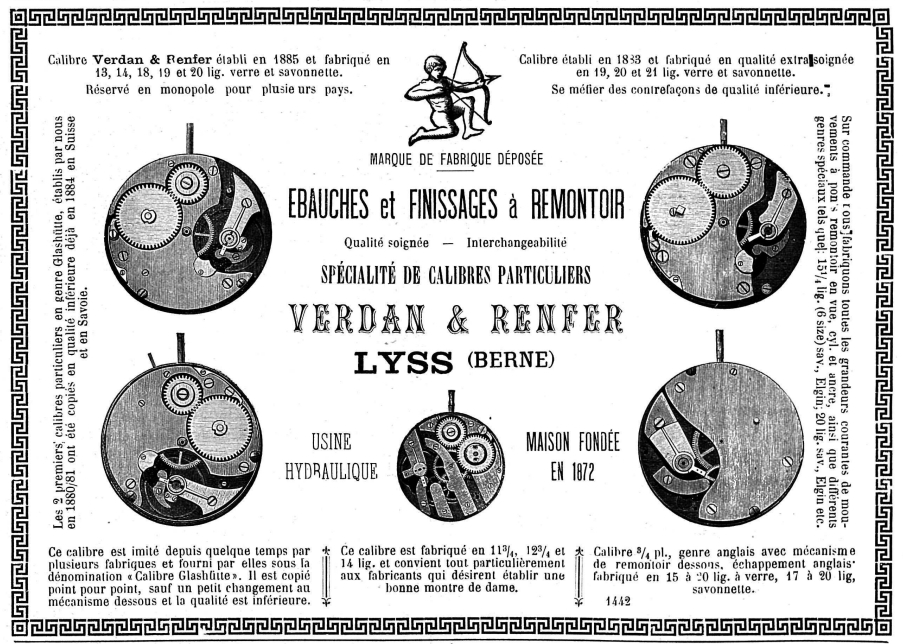
Three of the five pictured movements clearly show the Glashütte design. The inscription in the left margin is interesting:
Les 2 premiers calibres particuliers en genre Glashütte, établis par nous en 1880/81 ont été copiés en qualité inférieure déjà en 1884 en Suisse et en Savoie.
[The first 2 particular calibers in the Glashütte style, established by us in 1880/81, were copied in inferior quality already in 1884 in Switzerland and in Savoy (France).]
In this ad, however, they did not speak of the Système Glashütte, but of the Glashütte genre. The manufacturer, Verdan & Renfer, thus claims to have de facto invented the Glashütte genre.
Even older, but without mentioning the term Glashütte, is the Swiss patent CH2984 by Jacques Isely from December 1890, which describes a two-part three-quarter plate whose shape clearly points to Glashütte.

The patent shows the Savonnette (hunter) variant, I have the Lépine (open face) version here:
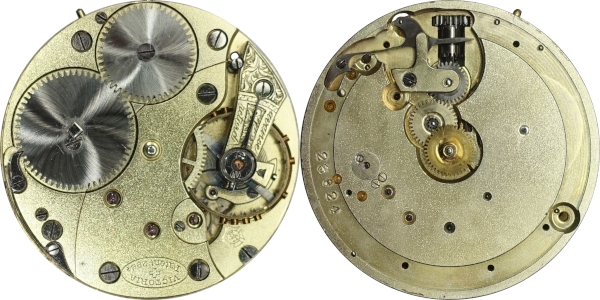
In the following advertisement from 1895, however, Syst. Glashütte is already mentioned. As you can see, with a price of 26 German Marks, these watches were not exactly in the lowest price category.

An advertisement from a Swiss mail-order company in Basel from 1901 also deals with gold-plated System Glashütte watches. Here, the German clientele was presumably in mind, since Basel is located directly on the German border.

And this 1902 ad also touts the Système Glashütte, which is the French-language version:
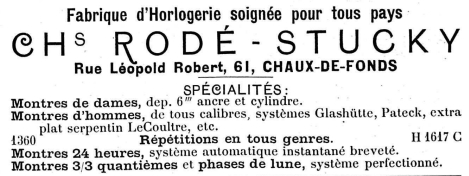
From today’s perspective, you can find quite funny dial markings in combination with System Glashütte. Here, the Beamtenfreund (civil servant’s friend) and the Wunderwerk (marvel, or wonderful movement), both trademarks registered in 1908 by the Swiss company Schwob frères in Switzerland and by the Jonass und Co GmbH in Germany.


Watches of the System Glashütte are still advertised around 1910, but the hype seems to wane significantly by 1915 at the latest. This may also have to do with the fact that Glashütte watchmakers began to take legal action against German subsidiaries of Swiss manufacturers in Glashütte around 1910, as they saw the term Glashütte not only as a mark of origin but also of quality.
The “heyday” of these clocks should therefore have been around 1895 to 1910. Despite the comparatively short time span, they are relatively common.

Unfortunately, the term System Glashütte says nothing about the quality of the movements. You can find both very high-quality and inferior movements here. The cases also vary from simple metal cases to real gold cases. Most of the manufacturers of the watches or movements didn’t seem to attach much importance to leaving their name on them. Thus, the actual manufacturer of the System Glashütte watches or movements can only be determined in exceptional cases. What is certain, however, is that there were numerous manufacturers who produced these movements.
Now let’s take a look at a few of these watches and movements.
Movement #1
First, a pocket watch, which bears the inscription System Glashütte on the dial:

After all, it says on the movement’s dust cover that this is a Swiss lever movement System Glashütte! So the misleading is kept within limits. The inside of the outer cover bears German and Swiss silver hallmarks, so the watch was clearly intended for export to Germany.
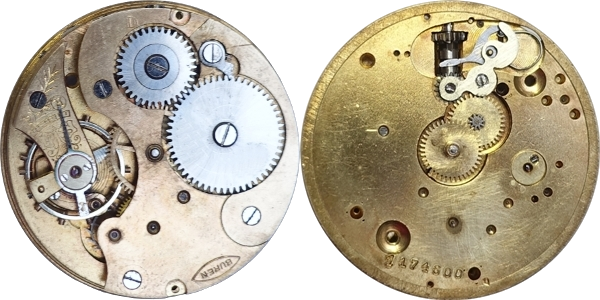
The manufacturer of the movement has immortalized itself on the gear train bridge. It is the Swiss company Buren. The owner, H. Williamson Ltd, registered this movement in 1903 as model No. 306 in the Swiss Official Gazette of Commerce.

The movement is only remotely reminiscent of movements from Glashütte, but has no resemblance to them except for the bridge shape. The three-quarter plate is not one at all, since the barrel bridge can be removed separately. Good for service, but just not a three-quarter plate. The movement is made in the cheap pillar construction and has only 11 jewels. Four bearings without jewels can be found on the dial side. The screw balance is not bimetallic and you won’t find screwed chatons or covered pallets here! So, not exactly a high-quality movement.
It is also interesting that the movement has a so-called negative winding. This is typical for American watches, since the winding stem with crown belongs to the case. Thus, movements and cases could be combined almost arbitrarily.
Movement #2
The second pocket watch bears the mark Eclair on the dial, which unfortunately was used by several watch manufacturers, so that a clear assignment is not possible.
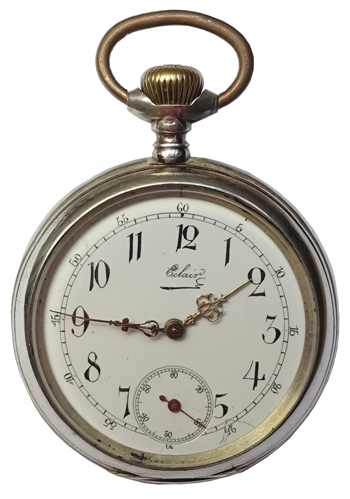
This watch has the term Système Glashütte on the dust cover. A dedication from 1902 on the inside of the outer cover allows for relatively good dating. German and Swiss silver hallmarks are also found here.

The movement of the watch has the typical shape of very many System Glashütte movements. It’s a Swiss lever movement with three-quarter plate, 15 jewels, a bimetallic screw balance with Breguet hairspring and covered lever pallets. So, a quite appealing quality! Unfortunately from a manufacturer unknown to me.
However, removing this movement from the case is not fun, since the set lever screw is located on the dial side instead of the bridge side. So, when installed, you first have to lift off the hands and remove the dial before you can pull the crown with the winding stem.
Movement #3
Unfortunately, the third movement came to me without a case. Again, no real three-quarter plate, but a Swiss lever movement with 16 jewels, a screwed center chaton, a bimetallic screw balance with Breguet hairspring and a swan-neck fine adjustment. All in all, it is of high quality. So far, I have seen this movement in the sizes 19, 20 and 21´´´.
The manufacturer is most likely the Fabrique d’Horlogerie de Fontainemelon (FHF). On the dial side, you can find a small cover plate on the clutch lever, which is marked in red on the picture. The shape of this plate is typical for older FHF movements from around 1900. FHF was a very large movement manufacturer, which produced about one million movements per year around 1913. So, the probability to find an FHF movement in a watch is quite high.
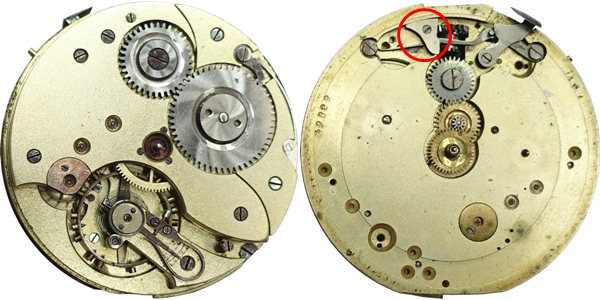
Movement #4
Movement number 4 is also likely to be from FHF. The construction is largely identical to that of movement #3. It lacks the swan-neck fine adjustment, but has got four screwed chatons. And instead of the small cover plate at the clutch lever, it has a motion work bridge, which is more modern. Common to movements three and four is the crown winding system with lever.

Movement #5
A bit younger is the following movement number 5, also from FHF. It is very similar to movement number 4, but has a more modern crown winding mechanism without lever. The Swiss patent number 51482 hallmarked on the dial side also belongs to this crown winding and hand setting mechanism. The patent issued to FHF dates from 1910.
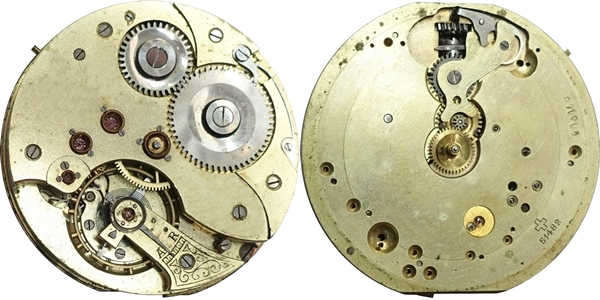

Movement #6
Although the sixth movement bears a dial with the inscription Système Glashütte, its construction is only remotely reminiscent of a three-quarter plate. However, the individual bridges are so close together that a cursory glance might lead one to believe that it’s a single plate. Completely untypical is also the indirectly driven minute, which leads to the fact, that there’s no minute wheel bearing visible on the bridge side in the center. The movement has got a diameter of 19´´´, a monometallic screw balance, a small second hand and only 11 jewels. Furthermore, it is a pillar construction, so it has got rather thin bridges. All in all, it’s a movement of lower quality.
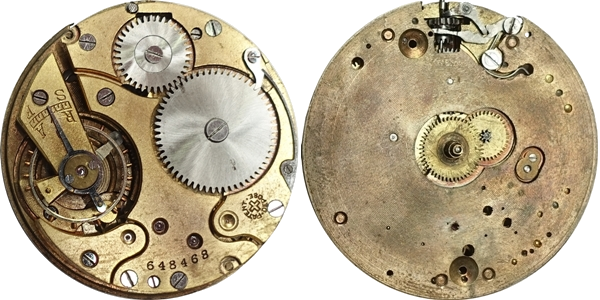
The Swiss company Malleray Watch Co. could be identified as the manufacturer, as they registered the movement in the Swiss Official Gazette of Commerce in 1912 as model no. 10.
Movement #7
The seventh movement is much smaller with a diameter of 13 1/4´´´ and might have belonged to a ladies’ pocket watch. With 16 jewels and a bimetallic screw balance with Breguet hairspring, it is quite well equipped. I could not identify the manufacturer yet.
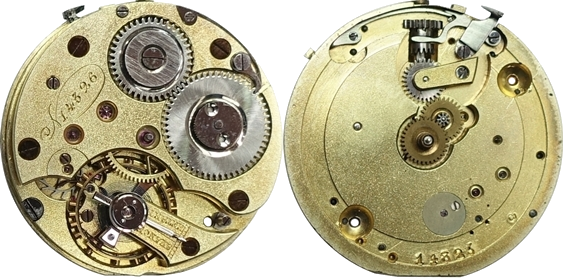
Movement #8
The eighth and last movement is a slightly different variant of the System Glashütte. It comes from the German company Dürrstein from Dresden, which sold watches under the brand Union, also called Glocken-Union (bell union) because of the logo, with movements in the Glashütte design that were made exclusively for it by a Swiss manufacturer. However, the company did not use the term System Glashütte.
With 15 jewels, a bimetallic screw balance, covered lever pallets and a swan-neck fine adjustment, it can definitely be seen.
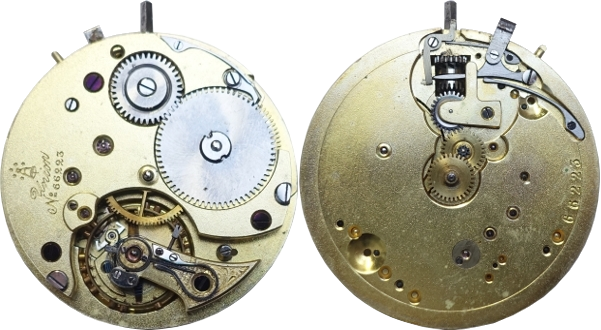

Click here for the second part with further information on the Glashütte system: System Glashütte – New insights

Good day. Thank you for sharing this information. I purchased a solid gold Systeme Glashutte in Vienna Austria 15 years ago from a watch dealer. It appears in great condition. No branding on the watch face but “N 170356 Systeme Glashutte “ inscribed on the inside of the back cover. Movement appears as photoed and described at the top of your post:
“Detail of a genuine Glashütte movement with covered lever pallets, gold escapement and escape wheel, screwed chatons and sunburst finish on the ratchet wheel”
Any further insight you might provide is appreciated.
Jim
Hello Andreas,
I very much appreciated reading your post/page regarding Systeme Glashutte.
I operate a small watch repair shop in Idaho. I have worked on a number of ‘American’ pocket watches over the years. about a year ago, I received (for service) a pocket watch movement that had been ‘set’ into a wrist watch case (becoming popular).
the dial said “Systeme Glashutte”. However, that dial ‘looked’ to be repainted (and not original due to the lack of patina for it’s age). the movement (18s ish) had NO markings indicating WHO mfg this movement. once the dial was removed, there was a ‘serial number’ on the main plate (dial side) but again, no other markings. since a mainspring was needed to ‘service’ this watch, I had to measure the old one to ‘locate’ something that would function.
the MAIN problem I came across, while disassembling the movement, was the cannon pinon.
it seems that the cannon pinon is ‘not’ friction fit to the center wheel shaft (as in most American pocket watches). it ‘seems’ that the Cannon Pinon has it’s OWN shaft (single piece) which passes through the main plate and the CENTER WHEEL, which is ‘fitted’ to this shaft. I’ve never come across this ‘style’/design and was puzzle as to how the ‘separation’ of the center wheel and cannon Pinon was to occur? knowing that it would be ‘impossible’ to locate replacement parts, I proceeded with caution.
but alas, was unable to separate the CENTER WHEEL from the CANNON PINON.
so I left this wheel intact (on the main plate) and proceeded to clean the watch parts in my ultrasonic cleaner.
After locating your webpage here, I see that MY movement and your EXAMPLE #3 seem to MATCH.
My movement also has the” small cover plate over the clutch lever/spring”. so, according to your research, my movent is an FHF and not a ‘Glashutte’.
thanks for this lead, I’ll continue to research FHF to see if I can find out more info on this movement.
regards
Bill
Meridian Watch Repair
I read this with great interest, having found many Swiss ebauche manufacturers advertising “Système Glashütte” before the turn of the century. I am glad you were able to explain to me what was happening here!
In researching this further in my archives, I was shocked to discover that the earliest obvious “fake” Système Glashütte advertisement was none other than Albert Jeanneret’s Usine du Parc in Saint-Imier! Yes, this is the famous Excelsior Park which I have written extensively about:
https://grail-watch.com/2021/10/07/the-power-of-steam-usine-du-parc-saint-imier/
Their 1890 ad includes shows that they were producing “Genre Anglais” and “Genre Glashutte” movements, which were certainly not English or German in origin.
Another remarkable one is an 1890 ad from Arnold Mathey in La Chaux-de-Fonds that specifically says “imitation Glashutte”.
I found many other interesting references from the 1890s as well, including an ad from La Fédération Horlogère seeking a producer of Glashütte movements in Switzerland and more “fake” movements from makers like Kummer in Bettlach.
Let me know if you’d like me to send on these documents, and thank you for your work!